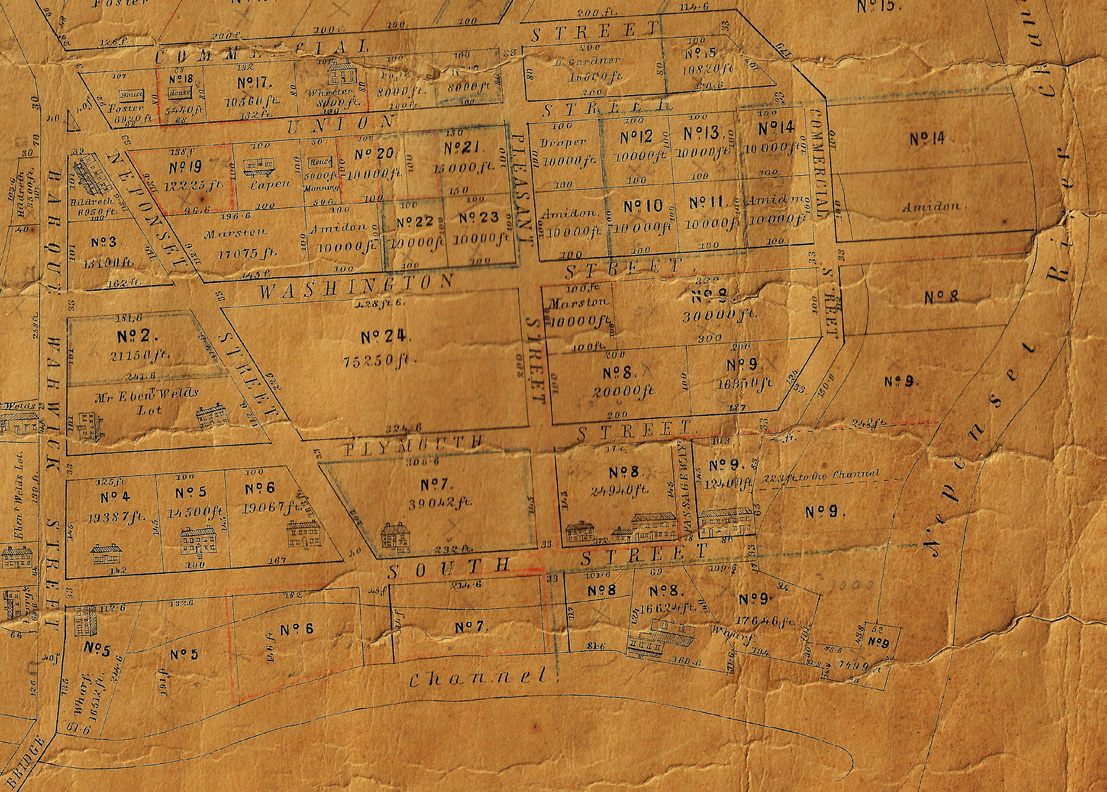Dorchester Illustration no. 2440 Commercial Point
Commercial Point is the home to the colorful gas tank we all see as we travel the Southeast Expressway as well as to the Old Colony Yacht Club. During the 19th century, the point was considered a good place for business pursuits. Today’s illustration is a section of an 1848 plan for Commercial Point, showing the streets at that time with illustrations of some of the Federal style houses built in the early years of the century. The plan is A Plan of Land belonging to the Commercial Point Association, Dorchester. Sept. 30, 1835, scale 60 feet to an inch, Thomas M. Mosely, Surveyor; reduced to a scale of 200 feet to an inch by Alex Wadsworth, Surveyor, Boston, July 1, 1848.
The following is from the 1859 History of Dorchester.
“In 1807, Joseph Newell and Ebenezer Niles purchased most of Commercial Point, where they built a wharf, erected a store, built vessels and commenced a large general trade. It proved that the location was for the time unfortunate, and that their means and business capacity were not equal to the emergencies, and the project fell through, with the ruin of the parties, in 1813.
Newell & Niles having been unfortunate in business, the Point was neglected, the buildings became dilapidated, and the place was for a long while neglected. For a time during the war of 1812, a regiment of soldiers was stationed there. About 1832 the place was again put in order, the fishing business was carried on to a considerable extent, and several whaling vessels were fitted out there. After a few years the concern was sold out, and the Point is now used (1859) for the coal and lumber business, and has a large forge erected on its north-eastern extremity.”
In 1836 Elisha Preston, Josiah Stickney, Charles O. Whitmore, their associates and successors were incorporated by Commonwealth as the Dorchester Whaling Company.
From an article about Captain John Codman (son of the minister at Second Church:
Few realize that Dorchester about 1832 was interested in whaling. A syndicate was formed for the prosecution of the whale and cod fisheries at Commercial Point. This syndicate was composed of Messrs. Nathaniel Thayer, a brother of John E. Thayer, the founder of the house of the well-known firm of Kidder, Peabody, & Co.; Mr. Elisha Preston, of Dorchester, who was the senior part of the firm of Preston & Thayer; Mr. Josiah Stickney, a well-known Boston merchant; and Mr. Charles O. Whitmore, of the firm of Lombard & Whitmore, whose residence was near the Point, and who acted as “ship’s-husband” for the vessels composing the fleet. Their goal was to whale in the Pacific, Indian, and North Atlantic oceans. The ships bought by the company were the “Charles Carroll,” of Nantucket; “Courier,” “Herald,” and bark “Lewis,” plus they equipped twenty schooners, of which two—the “Belle” and “the Preston”—were built at the Point. They purchased not only the wharf, but quite a tract of land in its immediate vicinity, where they put flakes for the drying of their codfish. They also built some cooper-shops and a store for the supply of sailors’ outfits and ship chandlery. The store was built from the material that came from the granary building which formerly occupied the site of the present Park Street Church in the city proper.”
As noted above, by 1859, the Point was used for the coal and lumber business. In 1872 Dexter Josiah Cutter started a heating fuel company at Commercial Point, bringing in wood and coal on boats. The 1874 atlas shows that the Boston Gas Light Company occupied the outer portion of the Point, and John Preston had a chocolate factory and wharf at the southeastern corner. In the 1880s the Boston Gas Light Company owned nearly all of the Point and added two gas holders (coal gas tanks) along with coal shed, retort house, purifying house, condensing house, machine shop and other buildings. D.J. Cutter maintained its coal yard at this located location through at least the 1930s. Later they became a heating fuel delivery company located farther north on Freeport Street.

